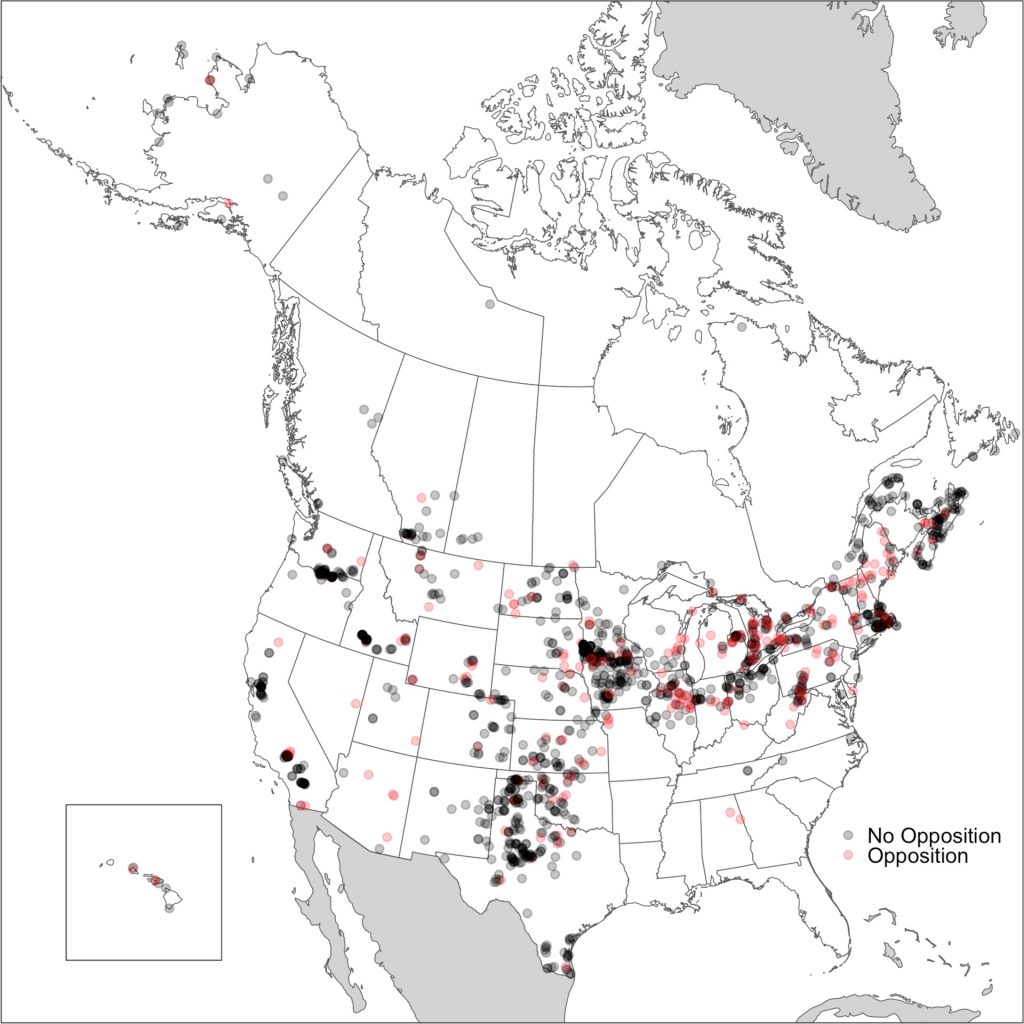The NIMBYs blocking the deployment of wind farms are overwhelmingly rich and white in the US and Canada, according to a new study.
Rich white people are wind farm NIMBYs
The study, “Prevalence and predictors of wind energy opposition in North America,” is newly published in the journal Proceedings of the National Academy of Sciences (PNAS) by researchers from UC Santa Barbara, the University of Michigan, and Gallup.
They examined wind energy projects throughout the US and Canada to determine how common opposition is and what factors predict it.
The study collected over 35,000 news articles to analyze 1,415 North American wind energy projects between 2000 and 2016. The study defined political opposition to projects as physical protests, legal actions, legislation, and letters to the editor.
In total, 17% of wind projects in the US and 18% in Canada faced significant opposition, with rates of opposition increasing over time, as wind energy has grown.

Spatial distribution of wind energy projects and opposition in the United States of America and Canada. Projects that experienced opposition are shown in red. Darker shades indicate a larger concentration of plants in that specific area. Source: PNAS study
In the US, opposition was concentrated in the Northeast in areas with a higher proportion of white residents and a lower proportion of Hispanic residents. In addition, the names of the people who opposed wind projects were overwhelmingly likely (92.4%) to be white.
In Canada, opposition was concentrated in Ontario and in wealthy communities. In both countries, larger projects were more likely to face opposition than smaller projects. The number of people engaging in opposition was small at a given project: the median number of protesters was 23 in the US and 34 in Canada.
The researchers termed this “energy privilege,” which they describe in the abstract as “wherein the delay and cancellation of clean energy in wealthier, whiter communities leads to continued pollution in poorer communities, and communities of color.”
Leah Stokes, lead author and associate professor of environmental politics at UC Santa Barbara, said:
Fossil fuel plants are predominantly located in poorer communities and communities of color. These plants create pollution. We need to replace fossil fuel power plants with clean energy, like wind and solar.
When wealthier, whiter communities oppose wind energy projects in their backyards, they extend the lifetime of fossil fuel projects. This is an injustice.
Electrek’s Take
For anyone who isn’t familiar with the term NIMBY, an acronym for Not In My Backyard, it’s a resident who supports something as long as it’s not put anywhere near where they live.
As in, “Oh yes, I am completely for wind power! I just don’t want it near me. It would ruin my view.”
This study looked at a lot of variables, from proximity to potential wind farms, to their economic potential for the local community, to turbine size. And what was striking was that, out of all the variables, the study found that in the US, “race and ethnicity variables are by far the strongest predictors of opposition.” Interestingly, it didn’t turn out to be a partisanship thing.
The paper’s bottom line – small numbers of white and wealthier people in rural areas are blocking wind farms. Or as they succinctly put it, “Opposition to clean energy is a privilege.”
Let us know your thoughts about this study in the comments below – and keep it civil, please.
Read more: New Jersey’s first offshore wind farm hits a milestone – and one county is fighting all of it
To limit power outages and make your home more resilient, consider going solar with a battery storage system. In order to find a trusted, reliable solar installer near you that offers competitive pricing, check out EnergySage, a free service that makes it easy for you to go solar. They have hundreds of pre-vetted solar installers competing for your business, ensuring you get high quality solutions and save 20-30% compared to going it alone. Plus, it’s free to use and you won’t get sales calls until you select an installer and you share your phone number with them.
Your personalized solar quotes are easy to compare online and you’ll get access to unbiased Energy Advisers to help you every step of the way. Get started here.
Read the full article here



